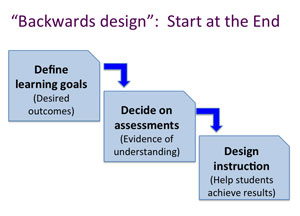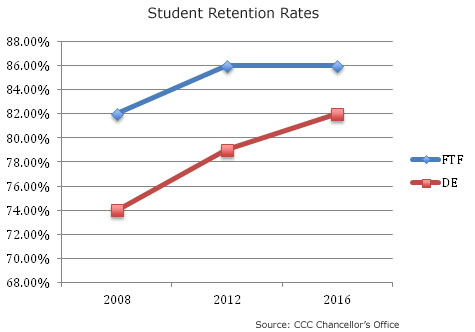(Warning: The first part of this blog is my own thinking about what we are accomplishing. The second is updates on the California Community Colleges (CCC) Online Education Initiative (OEI). If you are here strictly for the updates, feel free to jump to the middle of the post. Otherwise, you might enjoy my praise of online teachers and what they bring to higher education. I’m just sayin’.)
The OEI team spent most of last week at InstructureCon 2016 in Keystone, Colo., learning about both what we can do with Canvas, our chosen common course management system, and what we will be able to do with it as it grows with us. The experience of being in a camp-like setting with two thousand (yep, 2,000+) online educators caused me to consider the value this teaching methodology brings to our world.
As distance educators, we have spent years justifying and explaining why the work we do is important. I recall one particular curriculum committee meeting in 2004 when I had to defend project-based evaluation as the main form of accountability in my online interactive media course. People asked why I didn’t have a mid-term, and why my final involved building something based on criteria, in place of a multiple-choice exam. After all, didn’t Blackboard have a great testing tool, and why didn’t I want to use it?
A year later I had to defend my choice to not use a textbook. Instead I wanted to use the wonderful, completely current resources that were available online for free. Like me, many of us fought for online instruction in committee meetings, in the halls of our buildings, in boardrooms and department meetings. We designed and ran course management system workshops, created step-by-step how-to instructional materials, developed annotated images, learned to create and caption videos of ourselves, and more.
So, being with more than 2,000 online educators for three days really caused me to think about what we have contributed to higher education. In June, we had 850 in attendance at the Online Teaching Conference (OTC). I was able to tell the audience in the general session in San Diego that they were changing the face of teaching and learning in higher education, both for online environments and for the traditional on-campus world. We, online educators, have been leading innovation and creating effective teaching strategies for years, and it’s paying off.
InstructureCon 2016 attendees
Ways Online Instruction Informs Traditional Classroom Instruction
In a blog post that is part of a Stanford Center for Teaching and Learning newsletter called Tomorrow’s Professor, a study was highlighted that looks at how online instruction informs traditional classroom instruction. The gist of the work of Michael L. Rodgers and Mary Harriet Talbut of Southeast Missouri State University is that when professors have to consider the shift in method from face-to-face (ftf) to online, they have to reconsider how they teach. For some people, it’s the first time they have thought about the process of designing how they teach.
Discipline knowledge is important, but knowing how to convey that information to others is critical. Generally, the content of what we teach is the same in an online class, but the methods of instruction and the methods of evaluation are what change. Those of us who have designed and taught online courses understand that change is essential if we are to grow as professionals.
(Remember the OTC keynote discussion of “teaching malpractice,” which is teaching the same way we did 20 years ago.) I’d like to point out only a few of the many ways that online teaching can inform changes in our on-ground teaching world.
1. Needing to change the method requires support and necessitates collaboration.
Despite the differences, experience with online teaching can provide the instructor with an alternative expression of the course that reveals much upon comparison. The relative dearth of experience with online teaching (including a lack of mentors) requires the instructor to construct a workable pedagogy, or face numerous negative consequences. Few instructors prefer a teaching environment in which students are confused and discontented, and where students rate instruction as poor. The more highly collaborative course development process for online courses puts the instructor in contact with experts and established good practices, along with either explicit or implicit accountability for the quality of teaching. People generally perform better when others are watching.
—Rodgers, M., & Talbut, M. (2013, December 1). Can Online Teaching Improve Face to Face Instruction?
The excerpt above really nails the point. No teacher I know wants to teach poorly. We have, however, relied for years on teaching the way we were taught. Becoming a college teacher doesn’t require us to explore learning theory. We don’t have to have “teaching credentials.” We just have to know our discipline content. Creating a ftf course is really more of an individual task than we may realize. Creating online learning environments requires collaboration with others even if only to have someone else help you learn the tools! Designing differently requires reflection and organization. The thing I hear the most from new online teachers who have been taught to teach online is how the process has made them a better teacher, period.
I used to think that online teaching was a pretty isolating experience. Actually, it’s become the opposite. Over the years, our CCC online community has supported each other as we learned what practices worked and what did not. We have developed many ideas for successfully organizing course content and communicating with students. Doing that work as a teacher in isolation wasn’t too productive and, as we began using the resources the web allowed, we saw potential for new ways of presenting information, integrated activities that could be developed, and ways to allow students to perform authentically (see… “blogs”—authentic writing made possible). Out of necessity, we shared those ideas.
2. Changing the method causes a critical use of outcome-based design.
Around 2004, we were subjected to the dreaded “SLO” (Student Learning Outcome) by our accrediting agency. We suddenly had to figure out which SLOs were addressed the same way across courses and measure them. The application of SLOs after the course was being offered was seen as burdensome and caused (still causes) resistance.
Source: blog.sciencegeekgirl.com
Learning outcomes have to be the center of the online course design process and make total sense to new online teachers who are seeking to translate a course to online instructional methodology. Online design requires a teacher to look at what they want a student to know and be able to do, figure out how, in the new method, they are going to accomplish that, and then figure out how to evaluate the learning using available online tools. The first thing new online teachers ask is, “How are my students going to do the assignments?” In online course design it’s about “doing.”
An example from my interactive media design class would be about an assignment to build an effective commercial website. I’d want students to know about the business they are creating (for their client) and to determine what the intended audiences are for the site. I know what I want them to learn, but what do I want them to do?
I have to consider that all the work will be done in an online environment and how do I use what’s available there. I could have them do online research about the client’s type of business and then report out in a blog post that other students can then add information to in the form of comments. I could have students interview the business’ clients using a Google form and then use the results to create a set of design standards to submit to me as an Acrobat or Word file. I would have to assess each activity with a rubric that aligns to grading for the assignments.
It doesn’t take much to see how SLOs become useful when they are done in the initial design process. Creating outcomes at the beginning of designing an online course is critical for the course to be effective and gives teachers the opportunity to reconsider their teaching strategies in general. This process can be used in designing ftf courses, too, and is the foundation of a strategy called “Backward Design” if you are interested in learning more. The way an online course is designed requires the development of clear outcomes from the start, not applied after the fact to fulfill an accreditation standard.
3. Innovation using technology is essential in online teaching!
The transfer of technology used in online courses in enhancing ftf courses is really clear! More and more ftf teachers are using course management systems (CMS) to keep students, and themselves, organized. Being able to post changes in due dates, issues with course resources, and other announcements can assist a ftf teacher with communicating with students in so many ways. We now wonder how we did without these tools even 10 years ago!
Some of the biggest changes happen when ftf teachers really begin to use technology. Some examples are when ftf teachers integrate video production tools for students to use, such as Explain Everything, or have students write authentically in a blog, or use a CMS to provide rubrics connected to grades, or create resource collections that are available through the CMS. The use of these online teaching tools really has caused a shift in the ftf environment and it’s likely only the beginning.
Student Success & Retention Continue To Rise In Online Courses
One of the goals of the OEI is to provide resources to improve the overall quality of online courses. I’ve been working hard to not compare online to ftf, but rather compare resourced online to non-resourced online so that we can actually see what we need to work on.
I truly feel that the comparison of resourced online to non-resourced online is incredibly important and we are currently collecting that data for the courses we are working with. So, because of wanting to shift the conversation away from comparison to ftf, I hesitate to mention the next item but it’s an interesting comment on improvement in the ftf environment.
When Michelle Pilati and I were preparing for a presentation recently, she did some quick research at the Chancellor’s Office Data Mart. What she found was pretty interesting. (The chart shown here is just retention information.)
Which method is continuing to improve and which is flat? I’m no statistician, and know that some of you will jump all over me for this, but what if we find going forward that the improvements are related to innovation and resource provision at a high level for online education? What if the improvement is because we are paying closer attention to how we teach? If that is the case, then what we are doing as online teachers can really help improve on-ground teaching, too.
So, just think about where the change in methodology for all of us is coming from. Innovation is the name of our game as online educators. Don’t doubt that we have a lot to offer!
Beyond the advance of innovation the value of online education is, of course, the access we provide to students who cannot complete their educational goals without that access. I’ve spoken about this before and am preparing some reports from students to share next month. The most important reason why our work matters is because it makes education available to students. Transformation in how we teach is very much an intended consequence!
OEI Updates
Canvas adoption: We have over 90 colleges adopting Canvas! It’s amazing what, as a system, we can do! The CCC Canvas Community is growing and the developers at Canvas are paying attention to the “asks” we make there. I certainly don’t regret selecting Instructure as our partner. They continue to live up to their promises. We are revising the list of Canvas colleges on the OEI website to reflect which colleges have adopted and that information should be posted soon.
Portfolios: Online Portfolios are a hot topic these days and we will have an article about them in the next issue of CCC Technology for Student Success News. Watch for that in two weeks.
Additional funding: In case you are wondering, we did receive the approval of an augmentation of $20 million from the legislature. It’s one-time money, but we can do a lot with it to increase the inventory of online courses available to students across our colleges. We are also in the midst of preparing a proposal for an ongoing budget augmentation to allow for us to continue providing Canvas at no cost to the colleges. There will be more about these budget items in later posts, you can be sure.
Academic integrity: We have almost finalized a contract with VeriCite as a new option for plagiarism detection, which should be available through the Foundation for the California Community Colleges very soon! In addition, the on-ground proctoring network is finally being developed across the colleges and many of you will be hearing from us before the end of this year about how to participate.
OEI website and Canvas support: Our website is undergoing some renovation even though it’s only seven months old! Please be sure to look at the resources for learning to use Canvas that are located there. There are just-in-time videos for learning to use Canvas by function as well as step-by-step instructions that @ONE has made for us. While these links are direct to Canvas and @ONE, they are only two of a variety of resources available at our site, CCCOnlineEd.org. Please visit and explore all of the resources provided through the initiative.
—Pat
Pat James is Executive Director of the California Community Colleges Online Education Initiative




Leave a Reply
You must be logged in to post a comment.